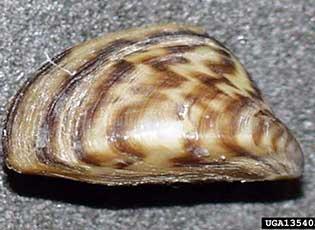Dreissena polymorpha (Pallas, 1771) (ITIS)
Zebra mussel
Eurasia (NAS Database)
1988 (NAS Database)
Ballast water (NAS Database)
Competes with native species; clogs pipes (NAS Database)

Zebra mussel, adult
Photo by Amy Benson; U.S. Geological Survey
Spotlights
Distribution / Maps / Survey Status
Federally Regulated
Videos
All Resources
Selected Resources
The section below contains highly relevant resources for this species, organized by source.
Council or Task Force
Partnership
Federal Government
State and Local Government
Academic
Professional
Integrated Taxonomic Information System. Dreissena polymorpha. [Accessed Sep 30, 2023].
Nonindigenous Aquatic Species Database. Fact Sheet - Zebra Mussel. USGS, Gainesville, FL. [Accessed Sep 30, 2023].
